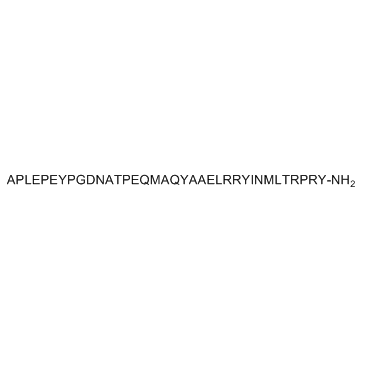179986-89-1
| Name | Pancreatic Polypeptide (bovine) |
|---|---|
| Synonyms |
APLEPEYPGDNATPEQMAQYAAELRRYINMLTRPRY-NH2
H-Ala-Pro-Leu-Glu-Pro-Glu-Tyr-Pro-Gly-Asp-Asn-Ala-Thr-Pro-Glu-Gln-Met-Ala-Gln-Tyr-Ala-Ala-Glu-Leu-Arg-Arg-Tyr-Ile-Asn-Met-Leu-Thr-Arg-Pro-Arg-Tyr-NH2 Pancreatic Polypeptide, bovine |
| Description | Pancreatic Polypeptide, bovine, a 36-amino acid, straight chain polypeptide derived primarily from the pancreas, inhibits secretin- and cholecystokinin-stimulated pancreatic secretion; Pancreatic Polypeptide, bovine acts as an agonist of NPY receptor, with high affinity at NPYR4. |
|---|---|
| Related Catalog | |
| Target |
NPYR4[1] |
| In Vitro | Pancreatic Polypeptide, bovine is an agonist of NPY receptor, with high affinity at NPYR4. Pancreatic Polypeptide (1 μM) does not alter proliferation in BRIN BD11 or 1.1B4 beta-cells, but reverses the decreased cell viability in BRIN BD11 cells induced by streptozotocin. Pancreatic Polypeptide (0.1 nM-1 μM) shows no effect on insulin secretion from isolated mouse islets, and does not affect the membrane potential and (Ca2+)i levels in BRIN BD11 cells at 1 μM[1]. Pancreatic Polypeptide, bovine inhibits secretin- and cholecystokinin-stimulated pancreatic secretion. 125I-Pancreatic Polypeptide, bovine shows no specific binding to pancreatic acini[2]. |
| In Vivo | Pancreatic Polypeptide (25 nmol/kg bw, i.p.) reduces glucose-stimulated insulin concentrations but shows no effect on acute feeding behaviour in overnight fasted mice[1]. Pancreatic Polypeptide, bovine (BPP; 40 μg/kg) inhibits CCK-33-induced pancreatic protein output during the entire bovine Pancreatic Polypeptide infusion period, but shows no effect on biliary protein output during CCK-33 or CCK-8 infusion[2]. |
| Cell Assay | To assess the effects of NPY and Pancreatic Polypeptide on rodent BRIN-BD11 and human 1.1B4 beta-cell proliferation, cells are seeded at a density of 150,000 cells per well and cultured overnight in the presence of NPY or Pancreatic Polypeptide (1 μM), and compared to positive control GLP-1 (1 μM). Cells are washed with PBS and fixed using 4% paraformaldehyde. After antigen retrieval with citrate buffer at 95°C for 20 min, tissue is blocked using 2% BSA for 45 min. The slides are then incubated with rabbit anti-Ki-67 primary antibody, and subsequently with Alexa Fluor® 594 secondary antibody. Slides are viewed using fluorescent microscope and photographed by DP70 camera adapter system. Proliferation frequency is determined in a blinded fashion and expressed as % of total cells analysed. Approximately 150 cells per replicate are analysed. For analysis of ability of NPY and Pancreatic Polypeptide to protect against streptozotocin-induced DNA damage, BRIN-BD11 and 1.1B4 cells are seeded. Cells are then exposed to streptozotocin (5 mM) in the presence or absence of NPY or Pancreatic Polypeptide (1 μM) for 2 h, with GLP-1 (1 μM) as positive control. Cells are then harvested and a comet assay is performed. Resulting gels are stained using DAPI (4′,6-diamidino-2-phenylindole) (100 μg/mL) and slides are viewed under appropriate filter. Comet score software is used for the analysis of % tail DNA (100 cells per gel) and olive tail moment[1]. |
| Animal Admin | Mice[1] Plasma glucose and insulin responses are evaluated after intraperitoneal (i.p.) injection of glucose alone (18 mmol/kg body weight) or in combination with test peptides (Pancreatic Polypeptide, etc.; 25 nmol/kg body weight) in overnight (18 h) fasted C57BL/6 mice. In a second series of experiments, 18 h fasted mice are used to assess the effects of respective test peptides on food intake. Mice receive an i.p. injection of saline alone (0.9% (w/v) NaCl) or in combination with test peptides (25 nmol/kg body weight) and food intake measured at 30 min intervals for 180 min. A dose of 25 nmol/kg is chosen with other NPYR modulators on glucose homeostasis, insulin secretion and feeding at this dose[1]. |
| References |
| Molecular Formula | C186H287N53O56S2 |
|---|---|
| Molecular Weight | 4225.78 |
| Storage condition | 2-8℃ |

